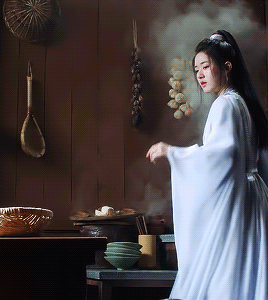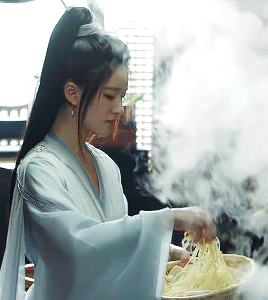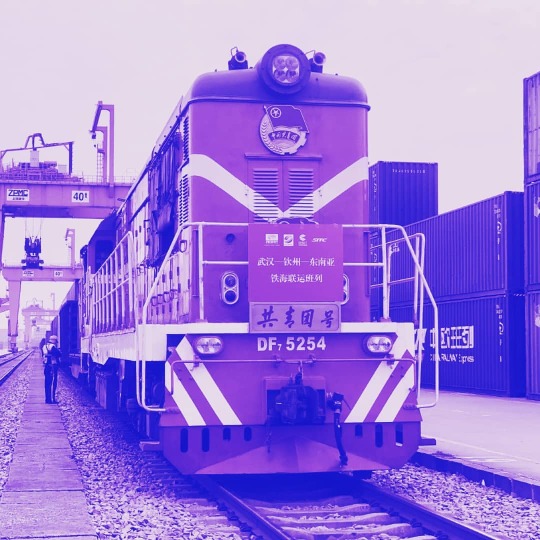#Leaving Qinzhou
Text
overhead a moon
and wilderness of stars
here and there
clouds and mist
this universe
is enormous
my road goes on and on.
Du Fu, Leaving Qinzhou
#Du Fu#Leaving Qinzhou#moon#moon quotes#full moon#stars#universe#travel#travel quotes#adventure#adventure quotes#Chinese literature#Chinese poetry#Tang poetry#poetry#poetry quotes#quotes#quotes blog#literary quotes#literature quotes#literature#book quotes#books#words#text
24 notes
·
View notes
Photo






Qie Shi Tian Xia (且试天下) / Who Rules the World
Episode 8 - Fengxi Makes Noodles for Fengxi
"You must be starving. What do you want to eat?"
"Don’t trouble yourself too much. Just take some Qinzhou Yellow Millet and make a thick bowl of porridge. Add some swallow’s nests and it’ll be good."
"... ..."
[later]
"All we have are noodles, take it or leave it."
[ID: Six gifs from Who Rules the World. Gifs 1 and 6 are wide -- 540 x 300 and span the entire row. Gifs 2-5 are 268 x 300 and are two on each row. Row 1, gif 1: Bok choy going into a wok with water. Row 2, gif 2: Bai Fengxi stirs the walk and turns around. Row 2, gif 3: Bai Fengxi reaches for a woven sieve. Row 3, gif 4: The sieve has noodles. Bai Fengxi takes some and tosses it into the wok. Row 3, gif 5: Bai Fengxi brings the bowl of noodles to Hei Fengxi who is in bed with his hair down. She sits down on the bed. Row 4, gif 6: Bai Fengxi’s hand holds the bowl of noodles and vegetables.]
Note: Qinzhou yellow millet was a tribute grain in the Qing Dynasty. Feng Lanxi's extensive privelege is showing.
#qie shi tian xia#cdrama#cdramaedit#且试天下#Who rules the world#QSTX#zhao lusi#bai fengxi#yang yang#hei fengxi#noodles#tw food#haoppo gifs
66 notes
·
View notes
Photo

Wuhan #Customs guaranteed the debut of the "Wuhan-Qinzhou-Southeast Asia" rail-sea combined freight train. The "Wuhan-Qinzhou-Southeast Asia" rail-sea freight train leaves wuhan Central Station of China Railway Union under the supervision of Hankou Customs on November 1. The train will arrive at Qinzhou Port in Guangxi province in two to three days, loaded with yarn, dried mushrooms and sodium sulfate, before being transferred to overseas markets. (在 China) https://www.instagram.com/p/CV0QOYFpDOW/?utm_medium=tumblr
0 notes
Note
17 Qiuyue
❤️17: How does your OC do during the zombie apocalypse?
Qiuyue is one of the last to know. The wolves are on edge as they leave the wild behind and go in search of food and she picks up on that but not why. Then they draw near a village or they come upon a road and she knows something is seriously wrong. She leaves the wolves behind to go and investigate and when she finds a zombie she’s quick enough to get out of the way. It doesn’t really matter to her that it’s a zombie. This is a world with demons and ghosts and this thing is going for her teeth first. She isn’t getting involved.
Qiuyue is going to initially see it as a singular occurrence. It would take travelling to somewhere more densely populated, a city, really, before she would have to face the fact that it’s not. The amount of zombies roaming outside the city walls would make her turn back. I think, and maybe this is just wishfulness on my part, that she would seek out Qinqin. But Qiuyue is a very in the moment character in that way and she’s just as likely to flee back to the wilderness with just the wolves. There’s also like 0.01 chance she’d at at least try to seek out He Hongyi but that would take her down south to what is approximately - in real life - Qinzhou.
The thing about the Jiangshan is that it is isolated. An emperor fucked up a few dynasties back and demons stopped people from coming in and out. All foreign trade and travelling effectively ceased and that wouldn’t change in a zombie apocalypse but Qiuyue would get far. Even if she, personally, had to travel more inland to get food for her and the wolves, I see her as living long and successfully. She’s skirted about the border before without any bother from demons before. If push comes to shove, she would team up with them if the threat came too close or it was the best thing all around for the wolves.
0 notes
Text
Prevailing element Of Adidas Adizero Shoes Is Comfort
Men's casual jackets and blazers are tee shirt maker from diverse fabrics and have wide-ranging cuts. Good examples of leather jackets comprise of motocross, motorcycle, duster and leather bomber coats. Denim coats are also quite attractive and be combined with denim jeans or even some other casual pant. Men clothes also include accessories like undergarments, hats, belts, socks, watches and shoes.
That's because it is! But if you want to know how to make your own T-shirt without using another company, that can be accomplished as well. Gather up any pieces of fabric, buttons, or other decorations you'd like to include in your T-custom t shirts design. Grab some permanent markers, your sewing kit, and go to town. You never know what you'll create, because one you know how to make your own T-shirt you'll find that it's hard to stop. Soon, your closet will be filled with original designs.
The material may be the first of what you should look out for when choosing shirts. Embroidery Services Singapore in pure cotton are the best options because they'll be soft, breathable and easy to look after. For men, Oxford casual shirts may be the most popular; the Oxford weave is more textured than a classic cotton poplin weave as the better formal screen print jersey.
Almost every day I went up to accompany her lingshan, so every day I average break time are not more than three hours, every time I take a rest when most of them are in the back of the car to lingshan and sleep. Or is cheap shirts custom made when business light, never have another good for sleep. She is unhappy up coax her,custom t shirt company x JS Mickey High, go shopping with her. Winter before daybreak to buy her breakfast, to nine like this I take bus back open hook machine. At that time I live such a life,, I swear I will is good for him. t shirt custom leave and she went to see her two elder brothers qinzhou prison.
commercial screen printing Adidas Samba trainers are designed and manufactured in a wide variety of colour combinations. However, t shirt customizing website with this shoe is the classic black with 3 white stripes. Embroidery Services Singapore goes best with a pair of jeans and white/black colour t-shirt.
Here's how it goes. You first buy a special type of paper that is designed for T-t shirt design. Afterward, you print the design unto that paper. The next step is then to heat-bond (iron) the design unto the shirt. Once you've done that, let the bond cool down, and the shirt's all set for you.
0 notes
Text
China’s ‘Belt and Road’ vision struggles to leave port
Grand plans for Qinzhou trade hub with south-east Asia yet to be realised
from Tumblr http://ift.tt/2pptVTD
0 notes
Link
New archaeological discoveries since the 1990s mandate the rereading of primary sources that have been foundational to the understanding of pre-1500 Asian history. While this study is specific to the revisionist history of fifteenth-century Vietnam, it has wider regional and international implications, notably as the new evidence necessitates the rethinking of Indian Ocean networking prior to the Portuguese seizure of Melaka in 1511. This study evaluates the rise and fall of the Champa coastline of southern and central Vietnam, where a series of ports were the major Indian Ocean route stopovers between the Straits of Melaka and South China’s ports from earliest times until the Vietnamese Dai Viet polity (using new gunpowder weaponry) defeated the Chams in 1471 and temporarily recentered the international maritime passageway stopover on the Vietnam coastline in Dai Viet’s Red River delta ports. This study also addresses recent scholarship that has promoted the South China Sea passageway as an “Asian Mediterranean.”
Hall, K. R. "Revisionist Study of Cross-Cultural Commercial Competition on the Vietnam Coastline in the Fourteenth and Fifteenth Centuries and Its Wider Implications." Journal of World History, vol. 24 no. 1, 2013, pp. 71-105.
The Champa network of port-polities on the central and southern Vietnam coast was subject to the ebb and flow of the international trade, reflected in the fluctuations in Cham sovereignty. Caught between the Indonesian and Malay domains to the south and the Chinese province of Jiaozhi to the north, the Cham realm’s early history was characterized by shifting alliances among regional centers that were concentrated at the river mouths of the Cham coast, a situation not unlike that of the Straits of Melaka Srivijaya realm that had linked the Straits of Melaka and Java Sea by the early seventh century. In contrast to Srivijaya, however, the Cham realm had major neighbors to its north (Jiaozhi) and west (the Khmer realm that would become Angkor).
The Cham “state” was dispersed among several competing river valley courts centered in productive downstream river valley ricelands that not only provisioned international traders making stopovers on their Straits of Melaka to China voyages, but also linked their coastal ports of trade to productive upstream highland sources of commodities in high international demand: elephants and their tusks; rhinoceros horns (ground rhinoceros horn is a prized aphrodisiac among the Chinese); cardamom; beeswax; lacquer, resins, and scented woods (sandalwood, camphor wood, and eagle or aloes-wood); areca nuts and betel leaves, the chewing of which gave teeth a distinctive red color; cinnamon; and gold. In contrast, Champa’s Dai Viet neighbor to the north, which was initially based in the fertile Red River plain and delta in and around modern Hanoi, exhibited developmental patterns toward centralization. When the Vietnamese Dai Viet state declared its autonomy from Chinese overlordship in the tenth century, its court’s proactive support of economic expansion in both its agricultural and commercial sectors would ultimately reinforce royal hegemony relative to competing elites and institutions.
[...]
But from the ninth century the Chinese called this middle region Zhan Cheng, “Cham city,” and developed separate tributary relationships with Zhan Cheng and Huan Wang. Cham records confirm this division, as separate kings were ruling from the Indrapura central regions of Amaravati in the north and the collective Panduranga Nha Trang/Phan Rang southern regions. In the eleventh century, the Nha Trang–based king Pramabodhisatya claimed a victory that consolidated Panduranga’s authority over the south. In the eleventh and twelfth centuries the southern Nha Trang– and northern Tra Kieu–centered polities began to interact on several levels with their Khmer neighbors to their west, notably as trade partners as overland commercial networking between Angkor and the Champa realm heightened. In the north were the port-polities of Amarendrapura, centered at Lai Trung near modern-day Hue, and Visnupura, centered at Nhan Bieu.
Nineteenth-century French archeologists were highly impressed with the remains of Cham urbanism and regional networking as they explored their new Indochina colony. They found primary and secondary centers linked in the Tra Kieu region, connected by road networks on raised embankments paved with stone, stone bridges built over canals, and urban ruins 16 feet (5 meters) high on stone foundations on a rectangle 984 feet by 1640 feet (300 by 500 meters). These elevated ruins were not military fortresses but strategically fortified palaces, temples, and diverse residencies.21
By the seventh and eighth centuries the Cham realm balanced its wet-rice economy and its participation in the international maritime trade engagements. An important factor necessitating this balance was the fact that the Cham coast was by then strategically located on the principal maritime route between the Srivijaya Melaka Straits–based realm and China, a position that allowed the Chams the opportunity to take advantage of the economic benefits offered by participation in the trade as the trade heightened in the Tang and Song eras (618–1279). In the eyes of the Chinese, Champa, though important, was ultimately a region of intermediary ports, the last stopover between the Straits of Melaka–centered Srivijaya realm and China before ships reached China’s ports-of-trade. In time, however, the Cham realm would become increasingly important as a source of commodities desired by the Chinese elite.
[...]
Research on Southeast Asia’s past since the 1990s has been backed by new archeological discoveries—new excavations of pre-1500 residencies, courts, and temples and shipwreck recoveries that collectively mandated the need to reread the surviving textual sources. This variety of new evidence has especially enhanced the vision of pre-1500 Vietnam’s economic history, with wider regional and greater international implications.22 The most recent research centers on the thirteenth to fifteenth-century Jiaozhi Yang network that effectively linked the Cham (south and central) and Vietnamese (northern) coastlines from the Mekong delta in the south to Hainan Island in the north and beyond to South China ports.23 Prior to the ninth century the Cham coastline was the major maritime route stopover for ships going to or from South China’s ports, as ships sailed directly from this collective commercial area to Hainan Island rather than calling at ports in the Gulf of Tonkin region to the northwest.24 This was in part because it was more efficient to sail directly north from Cham ports to China, but also because there were huge hidden rocks along the Gulf of Tonkin passage, which were finally removed by China’s Tang dynasty governor in the ninth century. Previously the passageway was so treacherous that navigators of large ships with deeper drafts would not chance the passage, but would instead offload their cargoes in Cham ports.25
From there trade commodities traveled north on smaller boats, or were more often transported overland by human porters and pack animals via the Central Highlands, connecting to the upper Mekong River and from there north via Khmer and Lao (Lu Zhenla) regions to the Nanzhao/Yunnan South China borderlands into Vietnam (Jiaozhi). 26 An alternative early terminus of this overland route was via the Ha Trai pass to Nghe An27 and from there to the Red River delta and Jiaozhi. Early merchants, pilgrims, and envoys all landed in the central Vietnam Cham region prior to making this overland passage to Jiaozhi (the Chinese name for the Red River–centered northern region of Vietnam prior to its independence from Chinese rule as the Dai Viet state in the tenth century). The overland route was also the source of Jiaozhi’s most desired highland trade products: gold, silver, aromatics, rhinoceros horn, and elephant tusks. The route also served as the Angkor- era Khmer realm’s primary access to the South China Sea, whether to Cham ports to the east, or to Dai Viet in the north. Khmer kings thus sent tribute to the Dai Viet court nineteen times in the 960–1279 era, in contrast to only five to the Tang China court.28
The Zhufanzhi 1225 report of the sea trade filed by Zhao Rugua, commissioner of foreign trade at Quanzhou, the principal South China port terminus of the international maritime route at that time, provides the following description of his networked port’s trade partner Qinzhou (in modern-day Guangxi Province, then the Song prefecture bordering the Gulf of Tonkin north of Dai Viet) and its contemporary marketplace activities, incorporating the late twelfth-century account of Zhou Qufei:
"All Jiaozhi’s everyday wares depend on Qinzhou, thus ships constantly go back and forth between the two. The boyi [trade] field is East of the river outside the town. Those who come with sea products to exchange for rice and cotton fabric in small quantities are called the Dan of Jiaozhi [people known as Dan in Guangdong]. Those rich merchants who come to [have their products graded] come from [Dai Viet’s] border area of Vinh Tuyen prefecture to Qinzhou, these are called “small present” (xiaogang). The “large quantity present” (dagang) refers to the envoys sent by the court [of Dai Viet] to trade here. The goods they trade are gold, silver, copper coins, aloes-wood, varieties of fragrant wood, pearls, elephant tusks and rhinoceros horn. The small traders from our side who come to exchange paper, writing brushes, rice and cotton with the people of Jiaozhi do not deserve much mention; but there are rich merchants who brought brocades from Shu [Sichuan] to Qinzhou to trade for perfume once a year, often involving thousands of quan of cash. Those merchants haggle over prices for hours before reaching an agreement. Once it is agreed, no one is allowed to negotiate with other merchants. When the talk has just started the gap between the asking price and the offer is often as huge as between heaven and earth. Our [Han Chinese] rich merchants send their servants to buy things to sustain their daily life and even build temporary residences and stay there, in order to frustrate the [Jiaozhi] merchants. Their rich merchants stay calm and use perseverance as a weapon. When the two merchants see each other, they drink together; and as time passes, they get along. Those smooth-talking ones cut or add a few [quan] so the prices from the two sides become closer and closer. [When the deal is made], the officers [at the markets] weigh the perfume and deliver the brocade for both sides to finish the deal. At the trading site the [Song] officers only levy taxes on the merchants of our side.29"
[...]
The tenth-century Song state monopoly over exports and imports had hindered China’s trade with Southeast Asia. This changed in the late eleventh century, when the late Song court opened additional designated ports of trade and then withdrew a variety of state restrictions. Previous Song-era policy had required ship registrations that confined their coming and going to a single China port, and also stipulated a nine-month maximum shipping window that effectively constrained Chinese ships on outward voyages to a single destination using the northeast monsoon and a mandatory return voyage on the subsequent seasonal southwest monsoon. This travel reality effectively restricted trade to specialized exchanges in only a few volume regional products such as camphor, pearls, coral, aromatic woods, Java’s black pepper, fennel, coriander, jamuju seeds, safflower, and textile dyes, all of which were in demand in China. When the subsequent Yuan dynasty removed these registration restrictions and sailing window mandates Chinese ships and traders finally had unlimited opportunities to travel among several networked ports of trade throughout the Southeast Asia region on China-based sojourns. Ethnic Chinese established semi-permanent residential communities in Southeast Asia as bases from which they might more efficiently travel to and from China marketplaces, carrying a variety of Southeast Asia products, or specialize in intra-island trading. Thus, the new historiography now depicts the early fifteenth-century Zheng He voyages, and the subsequent Ming dynasty redirection of their interests inward, as having little lasting significance relative to the Indian Ocean trade network other than reinforcing already well-established privatized Chinese trade in the Island regions, with legacies to this day (see Fig. 2).33
[...]
That same year, Thanh Tong complained to the Ming court that seagoing links between Champa and the Ryukyu Islands had resulted in a raid on the southern Dai Viet coastline. That he was proactive in his regional maritime initiatives following his capture of the Jiaozhi Ocean network is illustrated by several complaints to the Ming court: one from Melaka in 1481 asserted that Dai Viet had interfered with their embassy to the Ming court.47 In 1487, 1489, and 1495, the surviving Kauthara and Panduranga Cham port-polities used their remaining connections to Guangzhou to promote a Ming military intervention against Dai Viet, which the Ming court refused, citing that this “involved merchants and the vast maritime region” as this was counter to the post-1430s Ming restrictions on China’s Southern Seas (Nanyang) engagements.48 In 1497, following Le Thanh Tong’s death, Champa tried once more to gain the Ming court’s support for the restitution of the Vijaya region by arguing that “Xinzhou [Thi Nai] is our country that has long been occupied by Annan [Dai Viet],” and asked for recognition “so that in future days [the king’s son] can protect the area of Xinzhou port.”49
0 notes
Text
China’s ‘Belt and Road’ vision struggles to leave port
Grand plans for Qinzhou trade hub with south-east Asia yet to be realised
0 notes